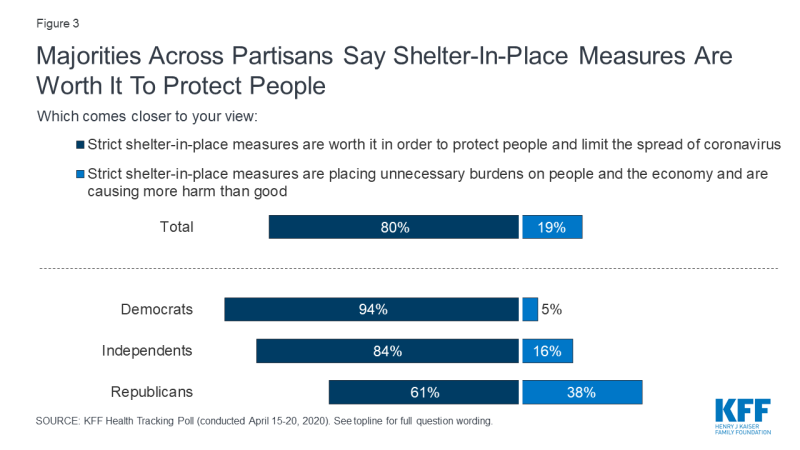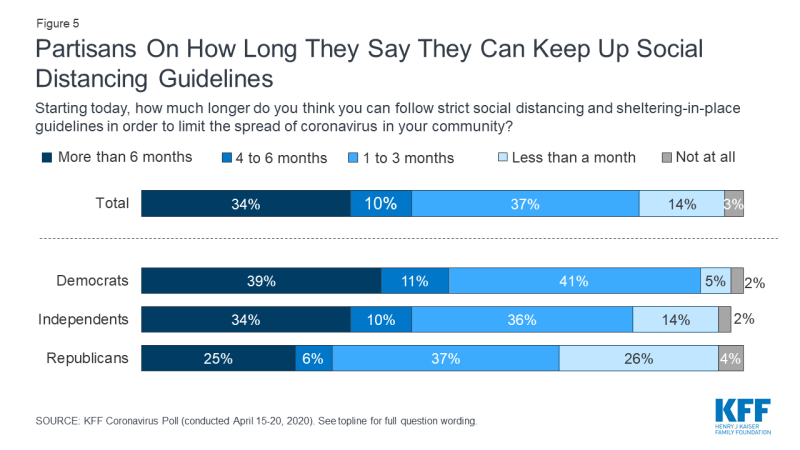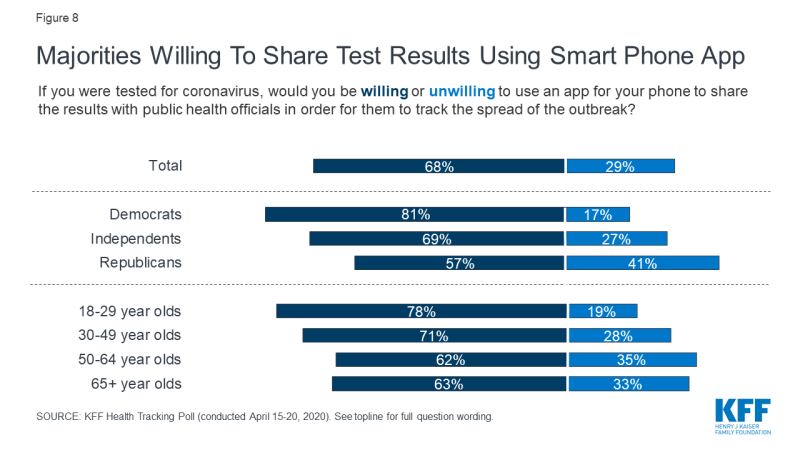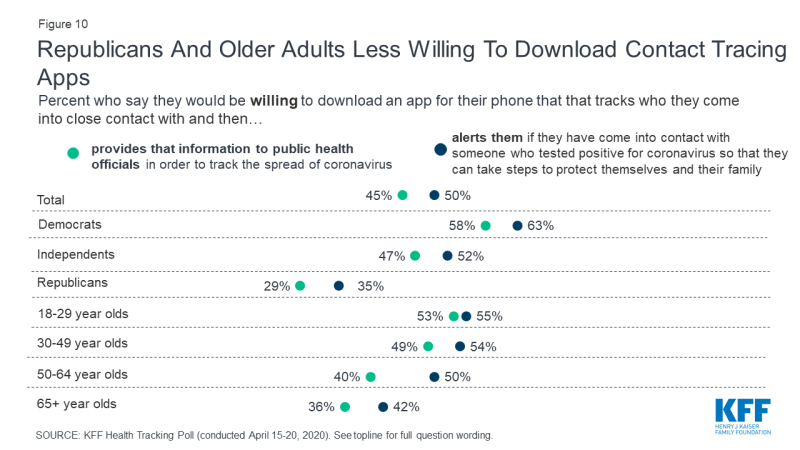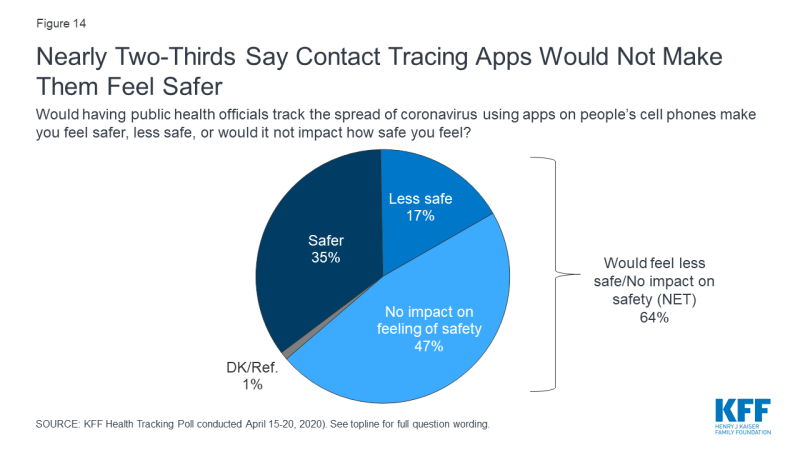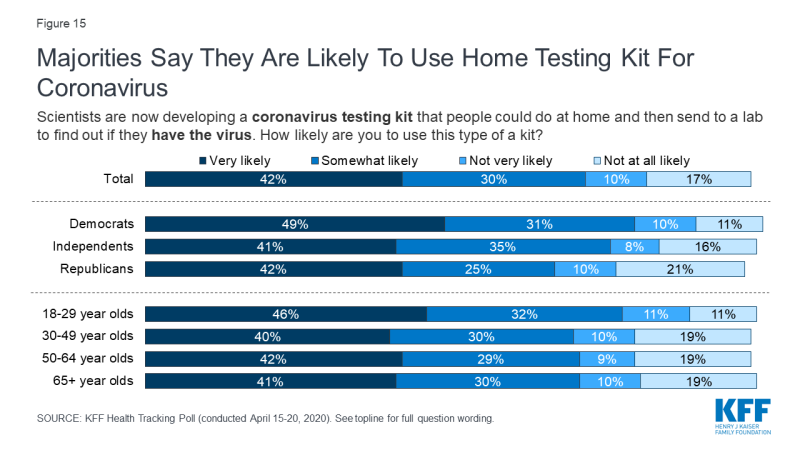KFF Health Tracking Poll - Late April 2020: Coronavirus, Social Distancing, and Contact Tracing
Key Findings:
- The latest KFF Health Tracking Poll conducted April 15-20th finds about half the public (51%) now saying that when it comes to the coronavirus outbreak in the U.S., “the worst is yet to come.” This is down 23 percentage points from the share who said the same (74%) in the Early April KFF Health Tracking Poll conducted less than three weeks ago. Majorities of Democrats (64%) and independents (56%) continue to say “the worst is yet to come,” but now twice as many Republicans say “the worst is behind us” (53%) as say “the worst is yet to come” (27%).
- While an increasing share of the public now say the worst of the outbreak is behind us, most Americans (80%) say strict shelter-in-place measures are worth it in order to protect people and limit the spread of coronavirus. Fewer (19%) say the strict shelter-in-place measures are placing unnecessary burdens on people and the economy and causing more harm than good. Majorities also say they can continue following strict social distancing and shelter-in-place guidelines for more than another month while less than one in five say they either cannot follow the guidelines at all (3%) or say they can follow the guidelines for less than a month (14%). While a majority of Republicans say they can follow social distancing guidelines for a month or longer, three in ten Republicans say they can either follow them “less than one month” or “not at all.”
- The severity of an outbreak in one’s area appears to be related to behaviors around visiting friends and family outside the home. Among those living in counties with 5 or fewer COVID-19 deaths, 36% say they have left their home at least once in the last week to visit with friends or family, compared with 21% of those living in counties with more than 25 deaths.
- The vast majority of adults (84%) say their lives have been disrupted at least some by the coronavirus outbreak in the U.S. This is up 12 percentage points from the KFF Health Tracking Poll conducted March 25-30 and up 44 percentage points from the March 11-15 poll.
- While the public is divided in their willingness to download apps for their phones as a way to trace and monitor the contacts of people infected with coronavirus, support increases to as high as 66% once people hear the argument that this could allow for many schools and businesses to reopen. Republicans are less willing to download and use a contact tracing app than Democrats and independents.
Over the past two months, the coronavirus outbreak has drastically changed the way of life in the U.S. With nearly 800,000 reported cases of the novel coronavirus in the U.S. and more than 42,000 reported deaths, many in the country are wondering when, if ever, normal life will return. When coronavirus led to the closing of schools and businesses in early March, the KFF March Tracking Poll found four in ten adults already reporting that their lives had been disrupted either “a lot” or “some” as a result of the virus. Now, five weeks later, the latest KFF Health Tracking Poll finds the share who say their life has been disrupted has more than doubled to 84%. This includes large majorities across race and ethnicity, gender, and parental status.
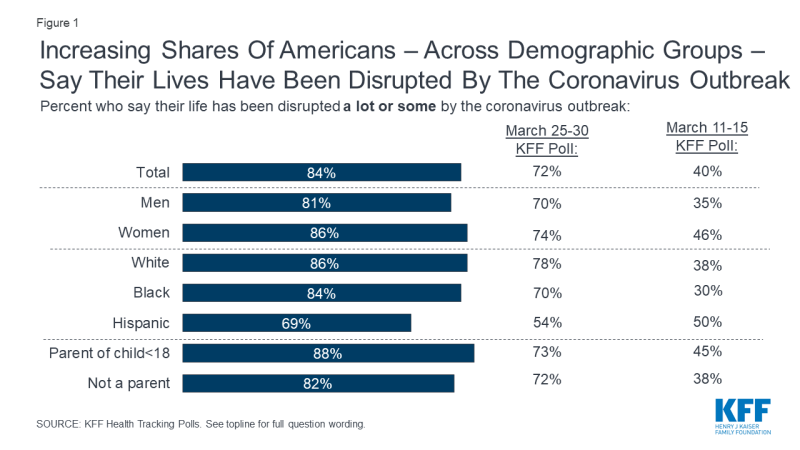
Figure 1: Increasing Shares Of Americans – Across Demographic Groups –Say Their Lives Have Been Disrupted By The Coronavirus Outbreak
At least eight in ten Republicans (82%), independents (81%), and Democrats (89%) now say their lives have been disrupted. This is more than a 50 percentage point increase from the far smaller share of Republicans (30%) who initially reported disruption back in early March, and a larger share of both independents (up 41 percentage points) and Democrat (up 40 percentage points) also now report their lives have been disrupted at least some by coronavirus.
Partisans Differ On U.S. Future Outlook and Support For Shelter-In-Place Measures
While the partisan divide on whether their lives have been disrupted by coronavirus has largely dissipated, there are now substantial partisan differences in people’s outlook on how coronavirus will impact the U.S. in the coming months.
In late March, a majority of the public said that when it came to the coronavirus outbreak in the U.S., “the worst was yet to come” (74%), while few (13%) said the “worst is behind us.” This included majorities of Democrats (82%), independents (77%), and Republicans (66%) saying “the worst is yet to come.” The latest KFF Tracking Poll now finds about half of the public (51%) saying the “worst is yet to come,” down 23 percentage points in less than three weeks. Majorities of Democrats (64%) and independents (56%) continue to say the “worst is yet to come,” but now one-fourth (27%) of Republicans say “the worst is yet to come” (down 39 percentage points from the March 25-30 KFF Poll). A slight majority (53%) of Republicans say “the worst is behind us,” while far fewer, but still twice as many who said this less than three weeks ago, independents (31%) and Democrats (21%) now say the same.
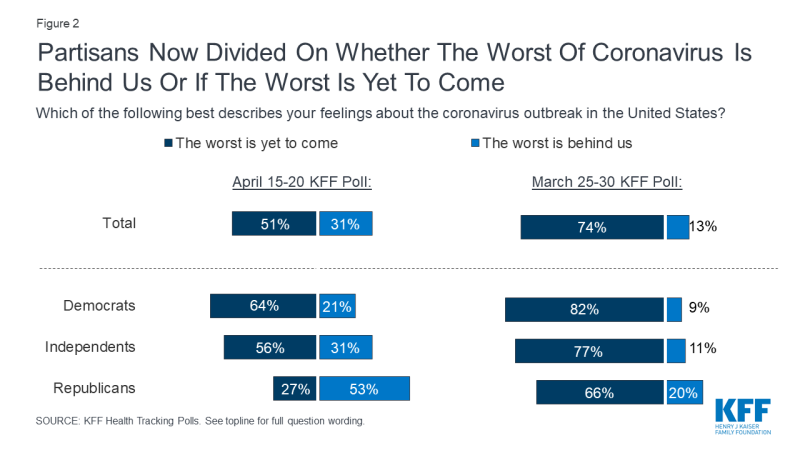
Figure 2: Partisans Now Divided On Whether The Worst Of Coronavirus Is Behind Us Or If The Worst Is Yet To Come
This partisan divide may reflect the mixed messages from governors, President Trump, and public health officials. While public health officials are warning about the possible impacts of relaxing social distancing measures, three Republican governors announced this week that some non-essential businesses will be allowed to re-open.
Despite this, a large majority of adults (80%) say strict shelter-in-place measures are worth it in order to protect people and limit the spread of coronavirus. Fewer (19%) say the strict shelter-in-place measures are placing unnecessary burdens on people and the economy and causing more harm than good. While majorities across partisans say these measures are worth it, a larger share of Republicans (38%) compared with independents (16%) and Democrats (5%) say they are causing more harm than good.
Some Republican governors have been among the strongest voices for re-opening businesses and lifting strict shelter-in-place orders sooner rather than later. However, even among Republicans living in states with Republican governors, a larger share say the strict measures are worth it (63%) than say they are causing more harm than good (36%).
| Table 1: Majorities Across Partisans Living In Republican-Led State Support Strict Shelter-in-place Measures | ||||
| Which comes closest to your view? | Living in a state with a Republican Governor | |||
| Total | Democrats | Independents | Republicans | |
| Strict shelter-in-place measures are worth it in order to protect people and limit the spread of coronavirus | 79% | 96% | 83% | 63% |
| Strict shelter-in-place measures are placing unnecessary burdens on people and the economy and are causing more harm than good | 20 | 4 | 16 | 36 |
Social Distancing and Sheltering-in-Place
Residents in most parts of the U.S. have been engaging in social distancing or sheltering-in-place for several weeks and all states, including Washington D.C., have issued mandates either restricting businesses, travel, or the activities of their residents. To see a complete list, see State Data and Policy Actions to Address Coronavirus.
Most adults (84%) say they have been sheltering-in-place because of the coronavirus outbreak and only leaving their home for essential services such as food, medicine, and health care – a similar share who reported this in the KFF Early April Tracking Poll (82%). Three-fourth of adults (76%) say they have bought or made a protective mask to wear in public, consistent with many social distancing guidelines issued by states. Those living in counties where more than 25 people have died from COVID-19 are more likely than those in counties with 5 or fewer deaths to report using a mask (82% vs. 69%).1
On April 16th President Trump announced guidelines for states to begin lifting shelter-in-place and social distancing restrictions in order to reopen businesses and get the economy going again2 but many states have announced that it could be weeks or even months until many shelter-in-place restrictions are lifted. With all of this uncertainty, the majority of Americans say they can continue following strict social distancing and shelter-in-place guidelines in order to limit the spread of coronavirus in their communities.
Eight in ten say they can follow strict social distancing and shelter-in-place guidelines for more than another month, including 37% who say they can follow the guidelines between 1 and 3 months, and one in ten who say they can follow them between 4 and 6 months. An additional one-third (34%) say they can follow them for more than 6 months longer, indicating there is a group of Americans who are willing to follow the guidelines as long as it takes to limit the spread of coronavirus.
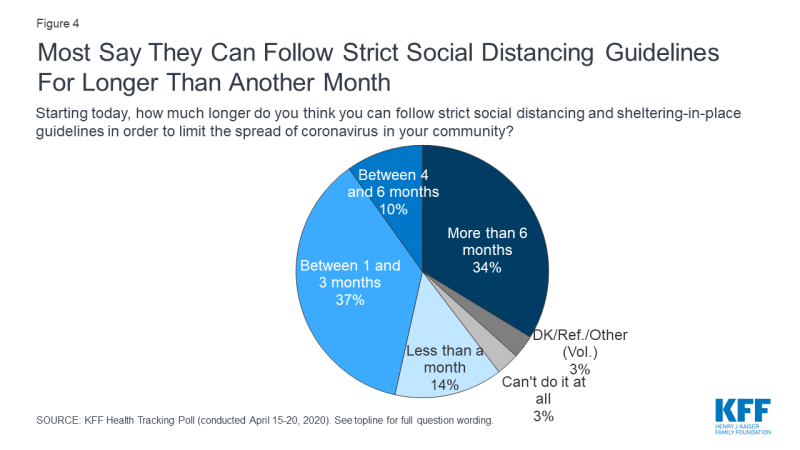
Figure 4: Most Say They Can Follow Strict Social Distancing Guidelines For Longer Than Another Month
On the other hand, there is a segment of the population who either isn’t willing to social distance for much longer or even at all. Nearly one-fifth say they can follow these strict guidelines for less than a month (14%) or say they are not willing to do it any longer (3%).
Majorities of Democrats (92%), independents (80%), and Republicans (68%) all say they can follow strict social distancing and sheltering-in-place guidelines for a month or longer, though Republicans are less likely than others to say they can sustain this practice for more than three months (31% compared to half of Democrats and 44% of independents).Three in ten Republicans say they can only follow strict social distancing and sheltering-in-place guidelines for less than another month (compared to seven percent of Democrats and 17% of independents).
With all states issuing either shelter-in-place or some social distancing restrictions (i.e., restricting the size of gatherings or closing schools), the majority of adults say they have not left their home at all during the last week either to visit close friends or family (70%), go to work (67%), or exercise (57%). About one in five (20%) say they haven’t left their home to shop for food, medicine, or essential household items but an additional 36% say they have only left their home once to do this.
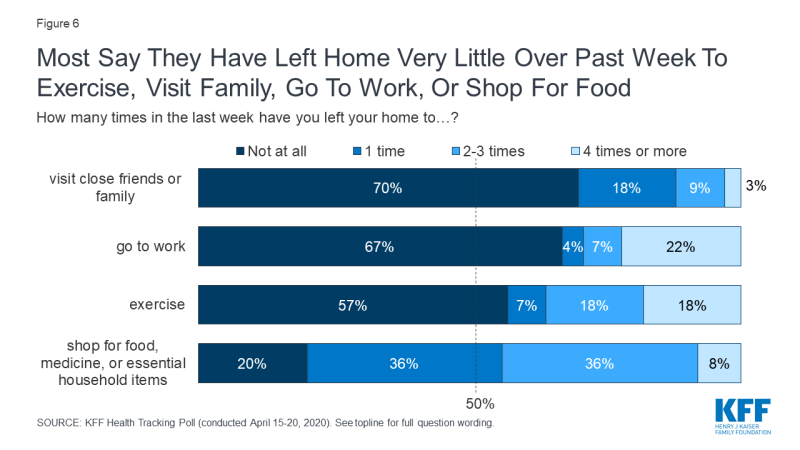
Figure 6: Most Say They Have Left Home Very Little Over Past Week To Exercise, Visit Family, Go To Work, Or Shop For Food
A small share (10%) of adults say they have left their home 4 or more times in the past week to either shop for food, medicine, or essential household items, or to visit close friends and family – activities that all leaders are encouraging people, even those who are essential workers, not to engage in or at least not often. This includes 7% of adults 60 and older who either have a chronic condition themselves or lives in a household with someone who has one, a group most at-risk for complications of coronavirus, who say they have left their home 4 or more times.
The severity of an outbreak in one’s area appears to be related to behaviors around visiting friends and family outside the home. Among those living in counties with 5 or fewer COVID-19 deaths, 36% say they have left their home at least once in the last week to visit with friends or family, compared with 21% of those living in counties with more than 25 deaths.
Essential Workers
While one-fifth of Americans say they have left their home 4 or more times in the past week in order to go to work, this is largely driven by those who have been deemed “an essential worker.” One-third (34%) of all adults say they have been deemed an “essential worker,” meaning they are still required to work outside their home during the coronavirus outbreak in the U.S. Three in ten adults earning less than $40,000 annually say they are essential workers compared to about four in ten of those earning between $40,000 and $89,999 (41%) or $90,000 or more annually (36%). A substantial share of essential workers (39%) say they or someone in their household has a serious health condition that could put them at higher risk of complications from COVID-19 and 13% of essential workers are over the age of 60.
Overall, most adults give themselves and the people in their household either an “A, excellent” for following the social distancing guidelines in their area over the past two weeks (53% and 52%, respectively) or a “B, good” (37% and 31%, respectively). A smaller share, but still a majority, give their neighbors or people who live near them either an “A” (35%) or a “B” (35%).

Figure 7: People Say They And Their Household Members Are Doing Better At Social Distancing Than Their Neighbors
Contact Tracing and Testing
One of the key elements in any plan to reopen businesses and restart the U.S. economy is widespread contact tracing, which is the ability to trace and monitor the contacts of infected people.3 One way to track the spread of coronavirus in communities is through people’s smart phones. Using smart phones for contact tracing is being widely discussed by public health officials and experts The latest KFF Health Tracking Poll finds the public divided on whether they would be willing to download an app for these purposes, but support increases once people hear the argument that this could help allow for many aspects of daily life to resume. Yet, the public is largely skeptical of the role of tech companies in managing this data and would like to see the data controlled by public health agencies.
Overall, a majority of the public (68%), are willing to use an app on their phone to share results from a coronavirus test in order to allow public health officials to track the spread of the outbreak. Majorities across age groups and party identification, say they are willing to use an app for these purposes.
The public is more divided in their willingness to download an app for their phone that uses Bluetooth and GPS technology to track who they come into close contact with. Half of the public are “willing” to download an app that alerts them if they have come in contact with someone who has tested positive for coronavirus so that they can take steps to protect them and their family while a similar share (47%) say they are “unwilling” to download such an app. The public are somewhat more “unwilling” than “willing” to download the app if they are told the app would provide information to public health officials in order to track the spread of coronavirus (53% who say they are “unwilling” to download the app compared to 45% who are “willing”).
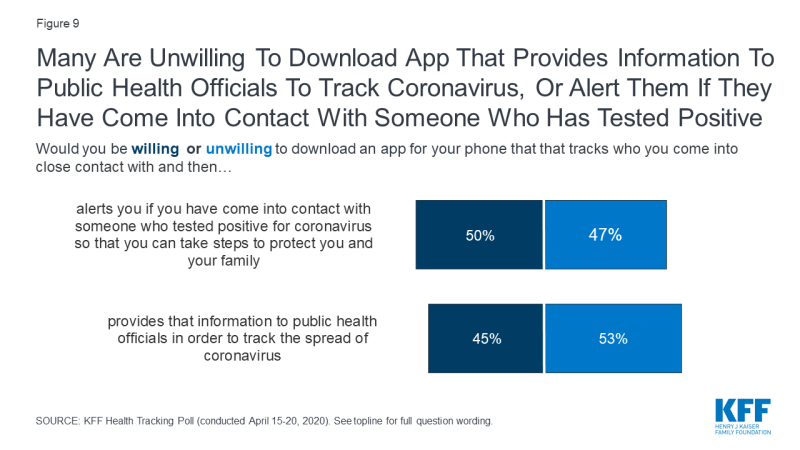
Figure 9: Many Are Unwilling To Download App That Provides Information To Public Health Officials To Track Coronavirus, Or Alert Them If They Have Come Into Contact With Someone Who Has Tested Positive
There are large differences across age groups and partisans in willingness to download contact tracing apps. While slightly more than half of 18-29 year olds saying they are willing to download an app that provides information to public health officials (53%) or alerts them if they have come into contact with someone who has tested positive for coronavirus (55%), smaller shares of older adults (65 and older) say they are willing to download an app for either of these purposes (36% and 42%, respectively).
Additionally, while about one-third of Republicans saying they are “willing” to download an app to help public health officials track the spread of the outbreak (29%) or alerts them if they have come into contact with someone who tested positive for coronavirus (35%), majorities of Democrats say they are “willing” to download an app for any of the mentioned contact tracing purposes (63% and 58%, respectively).
Some attitudes Change After Hearing Messages About Contact Tracing Apps
While initially divided on whether they would download an app for contact tracing, some may be willing to download the app once they hear that it would allow for many aspects of daily life to get back to normal. Two-thirds are willing to download and use the app once they hear that using such an app could allow more people to go back to work or school (66%) or that it would allow many businesses to re-open and start up the economy (66%). A smaller share, but still a majority, are willing to download the app once they hear that the app would give them information so they can talk to their doctor about what to do if they come into close contact with someone who has tested positive for coronavirus (62%) or that the data collection is “opt-in,” meaning people would have to actively choose to share the information (54%). About half (52%) are willing to download the app if the data collection is “opt-out,” meaning people would have to actively choose not to share information. Fewer are willing to download the app if they hear that they may get many alerts about being exposed to coronavirus, even if the exposure was only minor or the data could be potentially inaccurate (42%) or that there is a chance that data from the app could be hacked (28%).
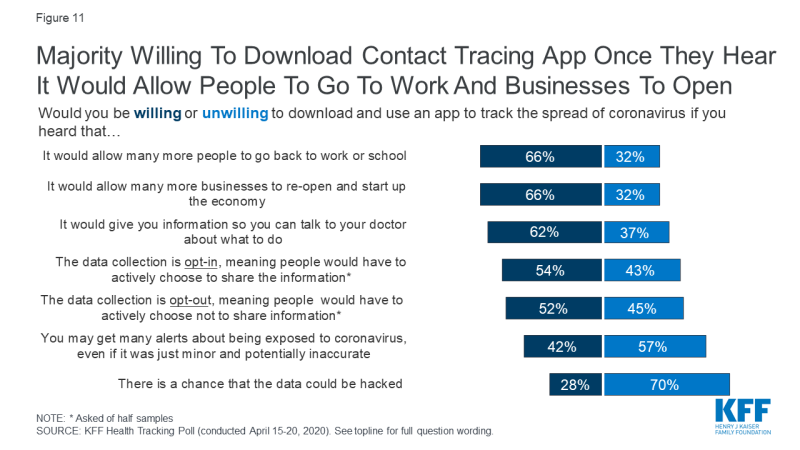
Figure 11: Majority Willing To Download Contact Tracing App Once They Hear It Would Allow People To Go To Work And Businesses To Open
Who manages the data also affects peoples’ willingness to download an app for contact tracing. Six in ten saying they are “willing” to download an app to track the spread of coronavirus if data from the app was managed by their state health department (63%), the federal Centers for Disease Control and Prevention (62%), or their local health department (62%). Far fewer (31%) are willing to download the app if the data was managed by a private tech company.
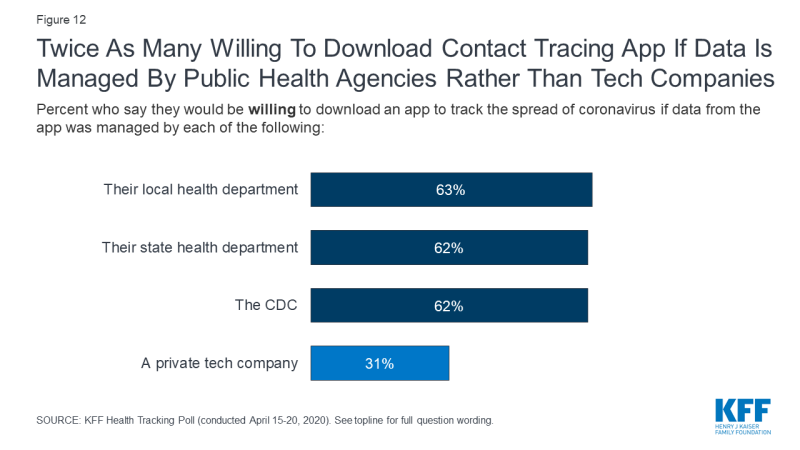
Figure 12: Twice As Many Willing To Download Contact Tracing App If Data Is Managed By Public Health Agencies Rather Than Tech Companies
While majorities of Democrats and independents and about half of Republicans are willing to download a contract tracing app if the data was managed by the CDC or their state or local health department, fewer than four in ten Democrats (37%), one-third of independents, and one-fourth of Republicans say they are willing to download such an app if the data was managed by a private tech company.
| Table 2: Who Partisans Trust To Manage Data From Contact Tracing Apps | |||
| Percent who say they would be willing to download an app to track the spread of coronavirus if data from the app was managed by: | Party ID | ||
| Democrats | Independents | Republicans | |
| Their state health department | 80% | 64% | 46% |
| The federal Centers for Disease Control and Prevention (CDC) | 75 | 64 | 47 |
| Their local health department | 78 | 63 | 48 |
| A private tech company | 37 | 33 | 26 |
This may be due to the fact that nearly four in ten (38%) say they are more worried private companies will sell their personal data from the app while one-third (33%) say they are more worried the federal government will use the data for purposes beyond tracking the spread of coronavirus. About one-fourth (22%) volunteer that they are equally worried about both of these things.
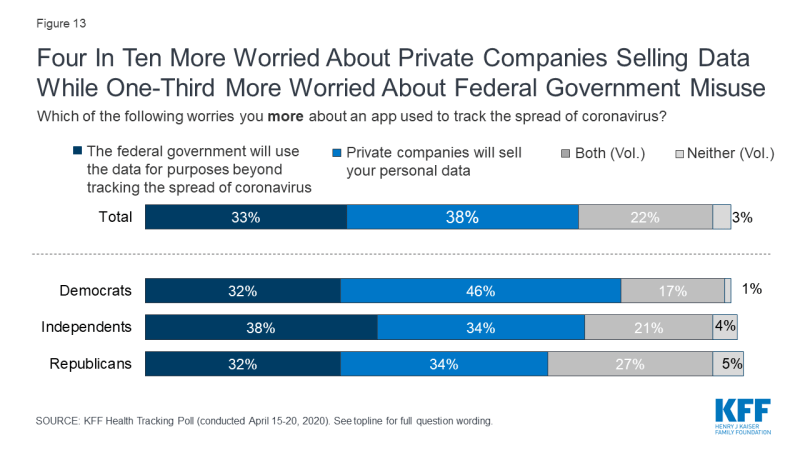
Figure 13: Four In Ten More Worried About Private Companies Selling Data While One-Third More Worried About Federal Government Misuse
Nearly two-thirds of the public say the use of contact tracing apps either wouldn’t have any impact on how safe they feel or say they would make them feel less safe. Half of the public (47%) say having public health officials track the spread of coronavirus using apps on people’s cell phones would have “no impact on how safe they feel,” while one-third (35%) say it would make them feel “safer” and one in five (17%) say it would make them feel “less safe.”
At-Home Testing
There has been discussion about the developments of a potential at-home testing kit for coronavirus with possible public availability. Seven in ten (72%) say they are either “very likely” or “somewhat likely” to use a coronavirus testing kit that they could do at their home and then send to a lab to find out if they have the virus. Unlike contact tracing apps, majorities across age groups and partisans say they are likely to use in-home testing kits.
Personal Experience with Coronavirus
Four in ten now say they either they personally know someone who has “tested positive for coronavirus” (24%) or personally know someone who thinks they had or have coronavirus, even if they couldn’t get tested (29%). One in ten (9%) now say they personally know someone who has died from complications related to coronavirus.
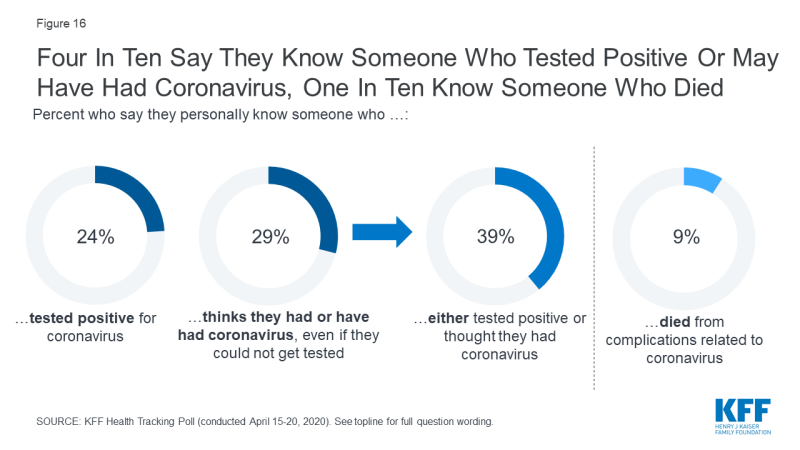
Figure 16: Four In Ten Say They Know Someone Who Tested Positive Or May Have Had Coronavirus, One In Ten Know Someone Who Died
Knowing someone who has either died from complications from coronavirus, tested positive, or had coronavirus does not lead to larger support for using smart phone technology for contact tracing.
| Table 3: Direct Experience With Coronavirus and Support for Contact Tracing Apps | ||
| Percent who say they would be willing to download/use an app for their phone … | Know someone who tested positive/had symptoms/died of coronavirus | Do not know someone who tested positive/had symptoms/died of coronavirus |
| … that tracks who you come into close contact with and then alerts you if you have come into contact with someone who tested positive for coronavirus so that you can take steps to protect you and your family | 53% | 49% |
| .. that tracks who you come into close contact with and then provides that information to public health officials to track the spread of coronavirus | 49 | 42 |
| … to share the results of your coronavirus test with public health officials in order for them to track the spread of the outbreak | 68 | 68 |

